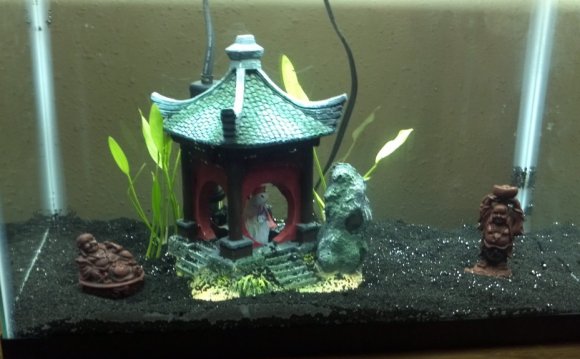
A species of Dracaena, Bamboo can survive in many indoor conditions, but indirect lighting is best as direct sunlight can cause the leaves to turn yellow and burn.
- Semi-aquatic
- Maximum height: 5'
- Shrubby, with slender stems
- Tank placement: Background
- Water temperature: 59-80ð F
- Ideal aquarium size: Large
- Can grow fully or partially submersed
Note: Plant availability is seasonal. State and local regulations may vary. Pricing may vary by store location.PetSmart stores cannot match the price above for this item. Ask a store associate for details.
Although it grows better in soil, Bamboo is often is sold with its roots in water, which makes it suitable for growth inaquariums or fishbowls containing Betta fish. The water in which Bamboo grows should be completely changed every two weeks;bottled water or de-chlorinated soft tap water are recommended. Bamboo does best in bright, indirectlighting and in temperatures from 59-80ð F (15 ðC-26 ðC).
*While safe for Fish, Bamboo is toxic if ingested by dogs or cats!
Clinical signs:
In cats: dilated pupils, abdominal pain, increased heart rate and drooling.
In both cats and dogs: vomiting, depression, inappetence, drooling, loss of coordination, and weakness.
Things to remember:
Water temperature:
Semi-aquatic plants require a tropical community aquarium with water temperatures ranging between 59-80ú F (15-26ú C). Usean aquarium heater to maintain water temperature.Adding plants:
Whether you're just starting your aquarium or introducing new plants into your tank, make sure to add only one or two plantsat a time.Lighting:
Most tropical plants require sunlight each day, year round. The duration and consistency are essential for plants to thrive.Natural aquariums must be equipped with the means to provide 12 hours of simulated sunlight each day.Plant fertilizer:
Fertilizer should only be added according to the dosage instructions on the label, and only when needed (as in the case of awater change). Plants will grow best if fertilized moderately and regularly after water changes rather than given larger quantities of fertilizer on a less-regular basis.Fish, amphibians and plants:
Toads and frogs are highly recommended for a natural planted aquarium- terrarium. Depending on the depth of the water and sizeof the amphibians and water temperature certain species of fish can be added.Water changes:
Test water weekly to assess water quality. It is recommended that 10% of youraquarium water be changed per week. At the very least, 25% of your aquariumwater should be changed per month. For optimal health, regular water changes not only prevent the undesirable accumulation of excess nutrients, but also remove excess nitrates and waste products of the fish and plants.Aquarium placement:
Place your aquarium in a low-traffic area, away from direct sunlight and drafts.Planting your natural aquarium:
Foreground plants: Usually stay very short and help fill in the front part of the aquarium.
Middle ground plants: These plants grow anywhere form 4-10 inches tall.
Background plants: These are the fastest-growing and tallest plants.
Things to watch for:
- Poor growth
- Brown spots on leaves
- Plants appear weak, pale green to yellow, stems have few leaves
- Plants cease to grow and die off
- Stem plants have long internodes and small leaves









